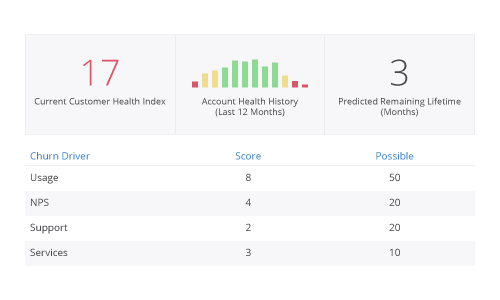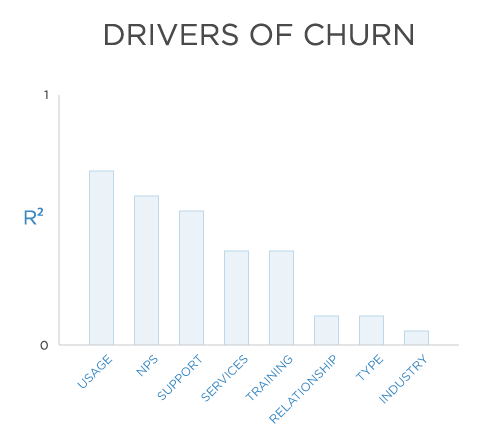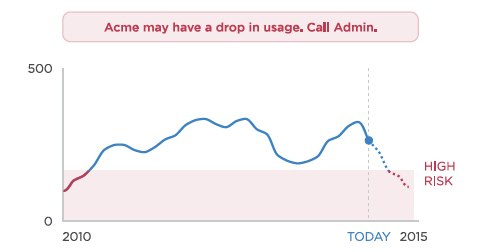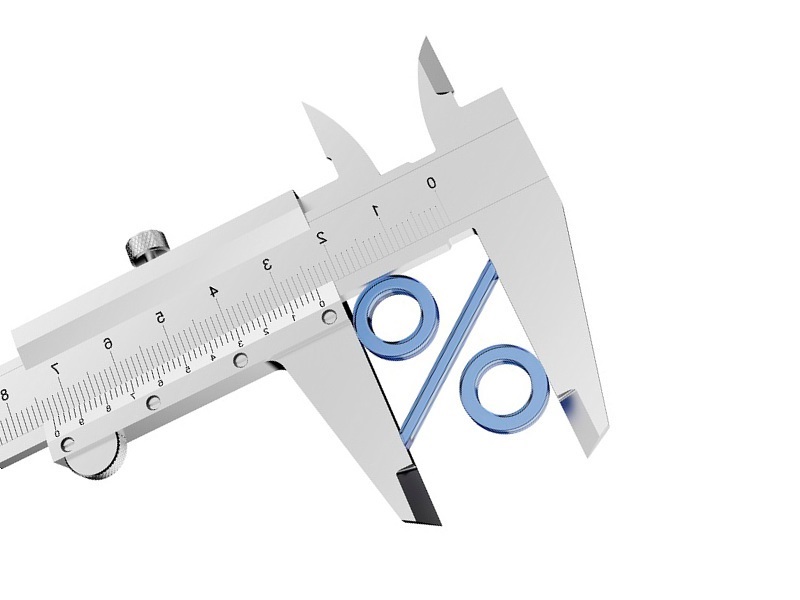Over the past few years, the SaaS community has gained a solid understanding of SaaS financial metrics, as well as many of the operational principles required to achieve them. However, there has always been an obvious gap between what happens on the top line and what happens on the ground. It’s one thing to claim that a 50% reduction in churn will result in a 2X increase in recurring revenue, but it’s quite another thing to make it happen. Achieving that 50% reduction in churn is usually a tedious and unreliable process of trial and error. This is about to change. As the SaaS industry matures, we are witnessing the evolution of SaaS metrics beyond simple, historical financial measures toward sophisticated operational measures in the form of new SaaS customer success metrics and predictive analytics.

We are witnessing the evolution of SaaS metrics beyond simple, historical financial measures
toward sophisticated SaaS customer success metrics and predictive analytics.
This is the second post in a series inspired by my ongoing collaboration with Bluenose Analytics that explores the new Metrics-driven SaaS Business and its foundation of emerging best practices in customer success metrics. [Attention SaaS CFO’s and VP’s of Customer Success! Please see the exclusive invitation at the end of this post if you like this series and would like to explore more in person.] The first post discussed the unique qualities of SaaS that enable the Metrics-driven SaaS business to apply a more analytic approach to management than traditional licensed software. This second post drills down on the promise of customer success metrics to bring greater rigor to the processes of churn reduction, upselling and customer success management for increased recurring revenue and decreased recurring costs of service.

An Ocean of Customer Success Data
The promise of customer success metrics is immense. Unfortunately, so is the challenge of developing them. From the initial capture of a prospect’s email address to the final cancellation of a churning customer account, the Metrics-driven SaaS Business collects and analyzes customer data. At the very beginning of a SaaS customer’s lifetime, a cookie is dropped and the usage clock starts ticking as web visits turn into trial accounts. That initial email is complemented with profile information captured on sign-up forms and augmented by third-party databases. Sales and marketing kick in and engagement activities are recorded in CRMs and marketing automation systems. Finally, a purchase is made and the ecommerce engine captures the transaction and forwards it to the financial systems for future billing. Then, the real action starts. Customers log in to the product again and again. Every important click is recorded and every customer success activity is logged.

The SaaS customer success metrics challenge is a big data problem,
requiring powerful data collection engines and sophisticated statistical models.
Collecting the data, unfortunately, is not even half of the battle. The Metrics-driven SaaS Business must make good use of it, turning data into information and information into action. Compared to the SaaS metrics challenge of previous years where all we had to do was master a relatively short list of SaaS financial metrics, the SaaS customer success metrics challenge is truly daunting–a bona fide big data problem. There is just no way to make sense of these volumes of data without powerful data collection engines and sophisticated descriptive and predictive statistical models. Simply defining the relevant customer success metrics is a difficult problem onto itself. But for the very first time, we have the law of large numbers tilting in our favor and the benefit it offers for reducing churn and accelerating customer acquisition far outweigh the costs.
Driving SaaS Customer Success with Metrics
The SaaS profit equation from the previous post and repeated below shows the five key financial levers of SaaS businesses, the two volume drivers: current customers and new customers, and the three units of value: recurring revenue per customer, recurring service cost per customer, and acquisition cost per customer.
SaaS profit =
current customers x ( avg recurring revenue – avg recurring cost )
– new customers x avg acquisition cost
[ Note: For the accountants in the audience,
this should look a lot like activity-based costing. Because it is. 😉 ]
As SaaS executives, our financial goals are very simple: make business decisions that push these financial levers in the right directions to increase revenue and reduce costs. The challenge of maximizing SaaS profit is easily divided between the ‘current customer’ half of the calculation and the ‘new customer, half. SaaS business organizations and operating plans are often similarly divided into servicing current customers and acquiring new customers.
This second post in The Metrics-driven SaaS Business series focuses on the ‘current customers’ half. The next post in the series will focus on the ‘new customer’ half. As mentioned earlier though, pushing these financial levers is much easier said than done. Planning to increase revenue by increasing current customers with a 30% reduction in churn is easy. Reducing churn by 30% is hard. The following sections take a look at the first three financial levers: current customers (churn), average cost of service (customer success efficiency) and average recurring revenue per customer (upsells) and the principal role of SaaS customer success metrics in creating and executing operating plans that actually push them.
Leveraging Root Cause Analysis to Reduce SaaS Churn
By far the lowest hanging fruit of SaaS customer success metrics is their use in SaaS churn reduction. For a SaaS business of any reasonable size, churn uniformly represents the largest financial drain on SaaS growth and profit. Its simple math, ‘current customers’ is almost always the largest number in our SaaS profit equation above. SaaS churn is also a great place to start our exploration of SaaS customer success metrics, because at its heart, SaaS churn is a statistical concept, so modeling it operationally is fundamentally a statistical problem.

[Note: If you tweeted the quote above, CONGRATULATIONS!
Welcome to the club of true SaaS metrics geeks! ]
SaaS churn represents the probability that a customer will cancel in a given period. That probability is determined by a number of factors: the value the customer sees in your SaaS product, the customer’s reliance on your SaaS product, the potential value of competitor offerings, and the internal priorities and politics within the customer’s organization. The Metrics-driven SaaS Business gathers and analyzes information on all of these predictors. Customer profiles in CRMs and accounting systems combined with direct product usage data go a very long way in describing the first two, whereas the less visible ones can be tackled through customer success surveys and expert ratings by executives, sales reps, support reps, and customer success reps.

With an ocean of customer success data and the law of large numbers on our side,
we can apply well known statistical methods to identify the root causes of churn
Once we have collected the relevant information, we can apply well known statistical methods to identify the root causes of churn. There are a number of descriptive statistical methods that apply from simple cross tabulation of churn cohorts to more advanced methods like logistic regression and survival analysis. Statistics aside, we expect to find insights, such as customers in healthcare are more likely to churn than customers in financial services. If a customer has not logged in in the last 30 days, it is at severe risk of churn. Customers that use our reporting module frequently are our best advocates, and so forth. With the right data and the right analytics, root causes of churn can consistently be identified and addressed, a significant improvement over simply reducing churn from 15% to 10% in our financial forecast without having a clue as to how it will be achieved.
Predictive Analytics with SaaS Customer Success Metrics
Once we have a better understanding of why past customers churn, we can create models that predict the risk that a specific current customer will churn in the future. With sound predictions, the customer success organization can take action to prevent SaaS churn before it happens. At their heart, most of these statistical methods are simply scoring systems that estimate the probability of a given event, in the case of churn it is the probability that a customer will cancel. The predictors in our models and the models themselves can therefore be used to create key performance indicators (KPIs) for customer success that are tracked on a regular basis for each and every customer. For example, we may find that customers that stop using our product for a two week period are at a higher risk of churn, and that the risk increases the longer they do not use the system. This metric and the regression that produced it can both be used to create KPIs.
SaaS Customer Success Metrics and Product Use
Customer success metrics based on product usage data is the secret sauce within the Metrics-driven SaaS Business. In a sense, churn is simply the opposite of use. The more a customer uses your SaaS product, the less likely the customer is to churn. Not only does use indicate how much the customer values your product, prolonged use correlates strongly with switching costs. Customer success metrics that track inadequate use are key indicators of churn, while those that track deep and frequent use are strong indicators of customer advocacy. One of the smartest applications of customer success metrics based on product use is driving product use itself. By identifying customers that are struggling with your product, you can uncover opportunities to improve the user experience, offer help and education, and of course reduce churn.

Product usage data is the secret sauce within the Metrics-driven SaaS Business.
In a sense, churn is simply the opposite of use.
Improving SaaS Customer Success Efficiency through Metrics
The same KPIs that we use for churn reduction can be applied to improve the efficiency of the customer success organization and thereby lower cost of service. They key is to go beyond simply monitoring and modeling customer success metrics to embedding them in the daily workflow of customer success reps. From the preceding example, if we know that customers that have stop using our product for two weeks are in need of immediate attention, then we can use this information to create dashboards and alerts for customer success reps. The primary goal is to direct the attention of customer success reps to customers where the reps can have the greatest impact on financial results. Conversely, the secondary goal is to not waste time on customer success activities that have no influence on the success of a customer.
The beauty of SaaS customer success metrics over SaaS financial metrics is that they apply at the individual customer level. Moreover, they can be rolled up along any dimension, such as time, customer type, product module, customer success rep, etc. to create a detailed picture of our customer success operation. At the individual account level, they can be used to create a scorecard or health index for every single account to help customer success reps monitor and manage their territories. At the aggregate level, they can be used to design the customer success territories themselves, so that customer success reps are deployed to customer accounts in the right numbers and with the right mix of skills. Customer success managers are usually familiar with a straightforward small, medium and large account approach to territory design, however, it might just be that your large accounts have the least risk of churn and the least potential for upsell! SaaS customer success metrics provide much stronger guidance and many more dimensions from which to choose for territory design.
Driving Upsells with SaaS Customer Success Metrics
SaaS customer Success metrics can also improve upselling to increase average recurring revenue per customer, the next financial lever in our SaaS profit equation. By applying the same types of statistical models we used in churn reduction to analyze past upsell purchases across customer demographics, product usage data, and so forth, we can develop predictive models and scores for upselling. Again, we can embed these models and KPIs into the daily activities of customer success reps or account managers to direct them to the accounts with the greatest upsell potential at any given time. Finally, we can use the predictive models within the product itself to automatically trigger communications with high potential customers and facilitate purchase.
Attention SaaS CFO’s and VP’s of Customer Success!
I will be speaking at an exclusive CFO only dinner sponsored by Bluenose Analytics this coming Tuesday, April 29 in San Francisco. Please email me directly at joelyork [at] chaotic-flow.com if you are interested in attending. This event is part of a larger, ongoing series designed to create an intimate setting for SaaS industry leaders (10-15 at a time at a nice restaurant) where they can discuss and evolve SaaS business best practices for finance and customer success. There are only a few spots left for next Tuesday, however, if there is sufficient demand, we will likely repeat it. There are also upcoming dinners focused on Customer Success operational best practices for VP’s Customer Success. If you are interested in these, please email me and I will send you the agenda. Bluenose is also considering expanding these dinners to multiple cities, so let me know even if you are not in the Bay Area.
Thanks again for following Chaotic Flow!
Cheers,
JY
PS Dinner is free!

[…] It is this realization that gives birth to the new Metrics-driven SaaS Business as it discovers the goldmine of SaaS customer success metrics and predictive analytics that enable it to eliminate churn before it […]
[…] Image Source […]
[…] Image Source […]
[…] Image Source […]
[…] Image Source […]
[…] Image Source […]
[…] Image Source […]
[…] Image Source […]
[…] Image Source […]
[…] Image Source […]
[…] Image Source […]
[…] Image Source […]
[…] Image Source […]
[…] Image Source […]
[…] Image Source […]
[…] Image Source […]
[…] Image Source […]
[…] Image Source […]
[…] Image Source […]
[…] Image Source […]
[…] specific KPIs that can indicate customer success are Net Promoter Scores (NPS), which tells you how likely a […]
[…] best practices in SaaS customer success metrics. The last two posts discussed the potential uses of SaaS customer success metrics for reducing churn and accelerating customer acquisition. This final post defines The SaaS Metrics […]
[…] best practices in SaaS customer success metrics. The last two posts discussed the potential uses of SaaS customer success metrics for reducing churn and accelerating customer acquisition. This final post defines The SaaS Metrics […]
[…] It is this realization that gives birth to the new Metrics-driven SaaS Business as it discovers the goldmine of SaaS customer success metrics and predictive analytics that enable it to eliminate churn before it […]
[…] It is this realization that gives birth to the new Metrics-driven SaaS Business as it discovers the goldmine of SaaS customer success metrics and predictive analytics that enable it to eliminate churn before it […]
[…] in customer success metrics. [Attention SaaS CFO's and VP's of Customer Success! Please see the exclusive invitation at the end of this post if you like this series and would like to explore more in person.] The first post discussed the […]